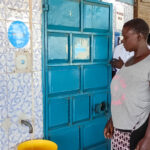Bonface Orucho
Commercial banks across Africa, both domestic and foreign, are stepping up their game to forge innovative green financing mechanisms that will bolster climate change mitigation and support the transition towards cleaner energy sources.
Three South African financial institutions—Standard Bank, Liberty Group and Stanlib Bank—have joined forces to launch a monumental US$1 billion fund aimed at facilitating the shift towards clean energy.
Reports on Afrik21 indicate the trio aims to raise the sum “in a few years.”
A statement from Stanlib details how Liberty and Standard Bank will provide US$160 million (R3 billion) in seed assets to be managed by Stanlib.
“The long-term goal is to create easier access to the asset class to mobilize capital from institutional investors such as pension funds, development finance institutions (DFIs), banks, SA Fixed Income funds, and the like to build this up to a $1 billion (R20 billion) pan-African investment vehicle,” the Stanlib statement explained.
According to Kenny Fihla, SBK Corporate and Investment Banking CEO, the fund “will offer compelling risk-adjusted and smoothed returns with a predictable income stream.”
This venture marks one of the most substantial commitments from African commercial banks towards climate action and green transition.
Standard Chartered took a significant step last year by initiating the African Natural Capital Alliance in collaboration with the UN Economic Commission for Africa. Their ambitious objective is to mobilise US$300 billion in climate finance by 2030. This is part of a larger global mission to raise US$17 billion in green financing by 2026, symbolizing a pivot away from fossil fuel investments and a stronger focus on green energy projects.
In Kenya, major commercial banks such as KCB, NCBA, ABSA, as well as Stanbic Bank, have recently reaffirmed their dedication to supporting the national green agenda.
NCBA aims to raise nearly US$200 million in green and sustainable financing by 2030, targeting grassroots initiatives promoting climate-smart projects through its vast network of 72 branches.
Similarly, the KCB Group, the largest financial service organization in East Africa, is determined to increase the share of green loans in its total loan portfolio to at least 25% by 2025, up from the current 8%. They’ve partnered with the UN Institute for Training and Research to provide 100,000 electric two-wheelers to riders over the next six years.
ABSA Bank Kenya is injecting US$40 million into climate-related investments by 2025.
These commitments are echoed in other key African financial markets, particularly in Nigeria, South Africa, and Egypt.
The collective efforts of these commercial banks are instrumental in expanding the array of locally available financing options for green projects, which are vital in addressing the pressing environmental challenges in Africa.
The World Bank estimates that Africa requires US$2.8 trillion between 2020 and 2030 for green initiatives, underscoring the importance of the financing initiatives.
Analysts are increasingly arguing that, given geopolitical issues and global inflation dynamics that further complicate Africa’s progress towards this financial target, the private sector, including commercial banks, is the most potent option for unlocking investment needed to realize green objectives.
The African Development Bank asserts that the private sector has the potential to inject over US$200 billion annually, despite contributing only US$4.2 billion in 2019/2020. The burgeoning trend among commercial banks on the continent is poised to narrow the gap.
Not to be left behind, multilateral institutions have also begun introducing innovative financial instruments on the continent. The Green Bank Initiative, an African Development Bank (AfDB) initiative, is in motion, with US $1.6 million in green funding facilities established in Benin and Ivory Coast. More is likely.
bird story agency
Commercial banks across Africa are increasingly developing green financing mechanisms to support climate change mitigation and the transition to clean energy. In South Africa, Standard Bank, Liberty Group, and Stanlib Bank have launched a US$1 billion fund to facilitate clean energy projects, with US$160 million provided by Liberty and Standard Bank as seed assets. This fund aims to attract capital from institutional investors, creating a significant commitment towards climate action.
Standard Chartered initiated the African Natural Capital Alliance to mobilize US$300 billion in climate finance by 2030, as part of its global mission to raise US$17 billion in green financing by 2026. In Kenya, banks such as KCB, NCBA, ABSA, and Stanbic have made substantial green financing commitments. KCB Group plans to increase its green loan portfolio to 25% by 2025, while ABSA Bank Kenya aims to invest US$40 million in climate-related projects by 2025.
The World Bank estimates that Africa needs US$2.8 trillion for green initiatives between 2020 and 2030, emphasizing the crucial role of private sector investment, especially commercial banks, in achieving these goals. The African Development Bank indicates that the private sector can potentially contribute over US$200 billion annually. Additionally, multilateral institutions are introducing novel financial instruments, like the Green Bank Initiative in Benin and Ivory Coast, to enhance green funding on the continent.







Hi to every single one, it’s in fact a fastidious for me to go to see this web site, it consists
of priceless Information.
Hello there, I found your website via Google at the same time as
looking for a related subject, your website got
here up, it appears to be like good. I have bookmarked it in my google bookmarks.
Hi there, just turned into alert to your blog via Google,
and located that it’s really informative. I am going to watch out for brussels.
I will be grateful should you proceed this in future.
Many folks can be benefited from your writing.
Cheers!